Description
A rice mill project report provides crucial insights for starting a rice milling business. It outlines costs, potential revenues, and profit margins to help you make informed decisions. Learn about essential licenses, equipment, and market analysis needed to set up your rice mill successfully.
Key Takeaways
Table of Contents
- 1 Key Takeaways
- 2 Rice Mill Project Overview
- 3 Why Start a Rice Mill Business in India?
- 4 Market Research for Rice Mills
- 5 Feasibility Study for a Rice Mill Business
- 6 Developing a Comprehensive Rice Mill Business Plan
- 7 Essential Licenses and Registrations
- 8 Cost Analysis of Setting Up a Rice Mill
- 9 Production Process and Capacity Planning
- 10 Marketing Strategy for Rice Mills
- 11 Revenue Streams and Profit Margins
- 12 Tips for Reducing Costs and Increasing Profits
- 13 How Our Rice Mill Project Report Can Help You
- 14 How Our Rice Mill Project Report Can Help You
- 15 Challenges in Rice Mill Business
- 16 Summary
- 17 Frequently Asked Questions
- India’s rice mill industry offers significant opportunities due to government support and growing domestic and international demand.
- Conducting thorough market research, feasibility studies, and developing a comprehensive business plan are essential for securing financing and ensuring profitability.
- Key challenges include managing seasonal supply of paddy, machinery maintenance, and waste management, which require strategic planning and sustainable practices.
Rice Mill Project Overview
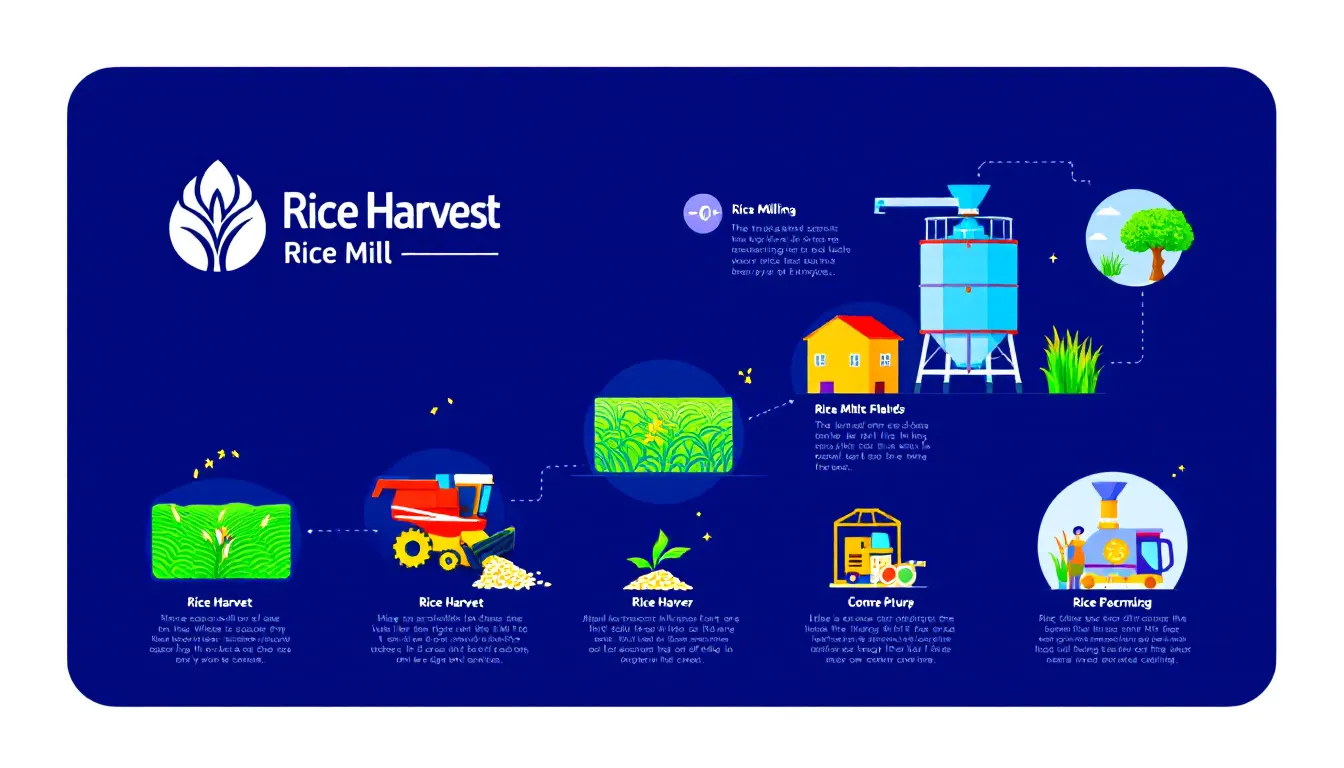
A rice mill is a facility where paddy grain is processed into polished rice and rice grain. The rice milling industry benefits from favorable pricing of paddy rice production, aided by government policies that support farmers. The demand for high-quality rice is growing globally, making the rice milling industry an essential part of the food processing industries. Starting a successful rice mill business can be rewarding if one has the right plan and equipment, especially when considering investments in rice mill plants.
Starting a rice mill business requires strategic planning and budgeting, considering necessary licenses, registrations, and initial investments for machinery and equipment. Project Report Bank provides consultancy services, conducts feasibility studies, and supplies equipment to help new businesses get started.
A well-prepared project report can be instrumental in securing loans and other financing options, making it easier to set up the business. Understanding the agricultural industry and leveraging government support allows entrepreneurs to establish a rice mill that thrives locally and internationally.
Why Start a Rice Mill Business in India?
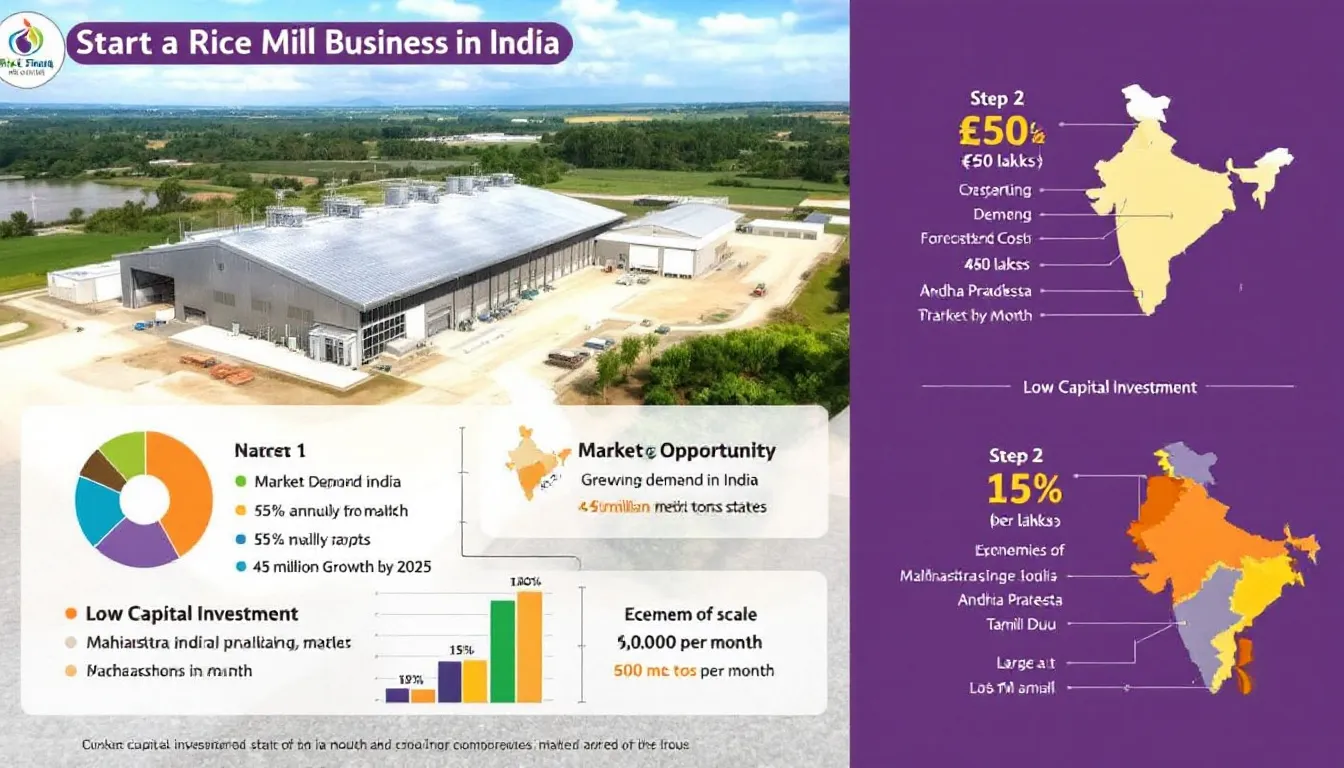
- Largest Producer: India is one of the largest producers of rice globally, ensuring a steady supply of raw materials for rice mills.
- Growing Demand: There is an increasing demand for rice both domestically and internationally, driven by population growth and dietary preferences.
- Government Support: The Indian government provides substantial support and subsidies to the agricultural sector, making it an attractive option for entrepreneurs.
- Rural Opportunities: Numerous opportunities exist in rural and semi-urban areas where rice mills can thrive due to the availability of raw materials and labor.
- High Returns: With proper planning and execution, starting a rice mill business in India can yield high financial returns.
- Market Dynamics: Understanding market dynamics and developing a comprehensive business plan can leverage local resources and government support.
- Profitability: By tapping into the growing demand and utilizing available support,
Market Research for Rice Mills
- Growing Demand: The global population increase drives the demand for rice, making rice milling a critical industry.
- Urbanization Impact: In India, urbanization and population growth are expected to significantly expand the rice milling sector.
- Consumer Preferences: Understanding consumer preferences for high-quality rice is essential for maintaining competitiveness.
- SWOT Analysis: Conducting a SWOT analysis helps identify business strengths, weaknesses, opportunities, and threats.
- Competition Analysis: Analyzing competitors in the rice milling business influences pricing strategies and profit margins.
- Supplier Availability: Assessing supplier availability ensures a steady supply of raw materials for rice mills.
- Customer Feedback: Gathering customer feedback is crucial for improving product quality and service delivery.
- Business Plan Development: Thorough market research informs the creation of a business plan that positions the rice mill for success.
Feasibility Study for a Rice Mill Business
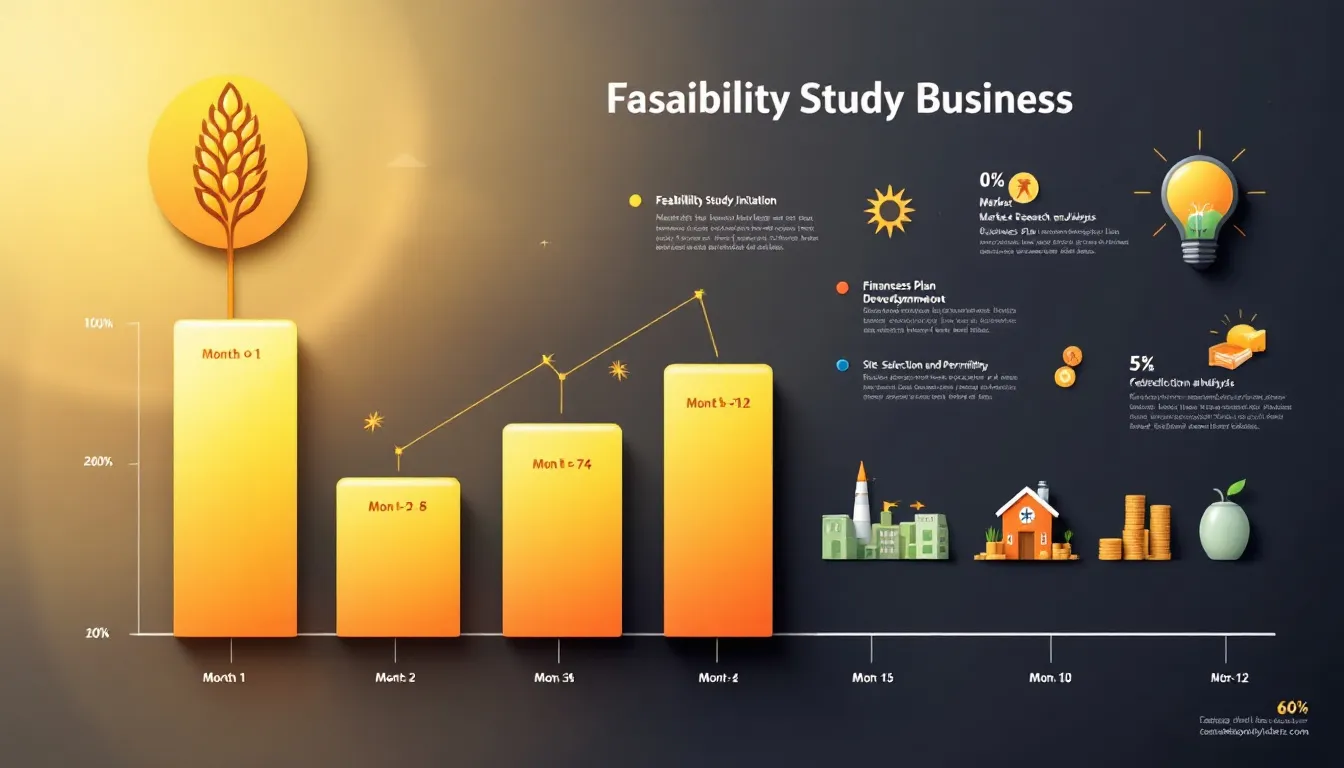
- Market Analysis: Evaluate the demand for rice, both domestically and internationally, and identify target markets to ensure a steady flow of potential buyers.
- Competition Assessment: Analyze existing rice mills in the area to understand competitive dynamics and identify unique selling propositions.
- Location Selection: Consider access to transportation networks, utilities, and proximity to paddy suppliers to reduce operational costs and ensure smooth operation.
- Financial Projections: Develop realistic financial forecasts, including revenue streams, expenses, and anticipated profits for at least three years to determine the project’s viability.
- Cost Estimation: Calculate costs related to land acquisition, machinery, labor, and construction, considering factors like civil construction and installation costs.
- Resource Availability: Ensure a consistent supply of raw materials, such as paddy grain, and assess the availability of skilled workers for efficient operations.
- Risk Analysis: Identify potential risks, such as seasonal supply fluctuations and machinery breakdowns, and develop strategies to mitigate these challenges.
- Marketing Strategy: Outline plans for reaching the target market, including digital presence and local advertising to enhance market demand.
- Legal Compliance: Verify necessary licenses and registrations, including factory licenses, GST registration, and food safety certifications, to ensure legal operations.
- Sustainability Practices: Explore eco-friendly practices for waste management and energy use to enhance long-term profitability and compliance with environmental regulations.
By conducting a comprehensive feasibility study, entrepreneurs can assess the viability of their rice mill project and make informed decisions for a profitable business.
Developing a Comprehensive Rice Mill Business Plan
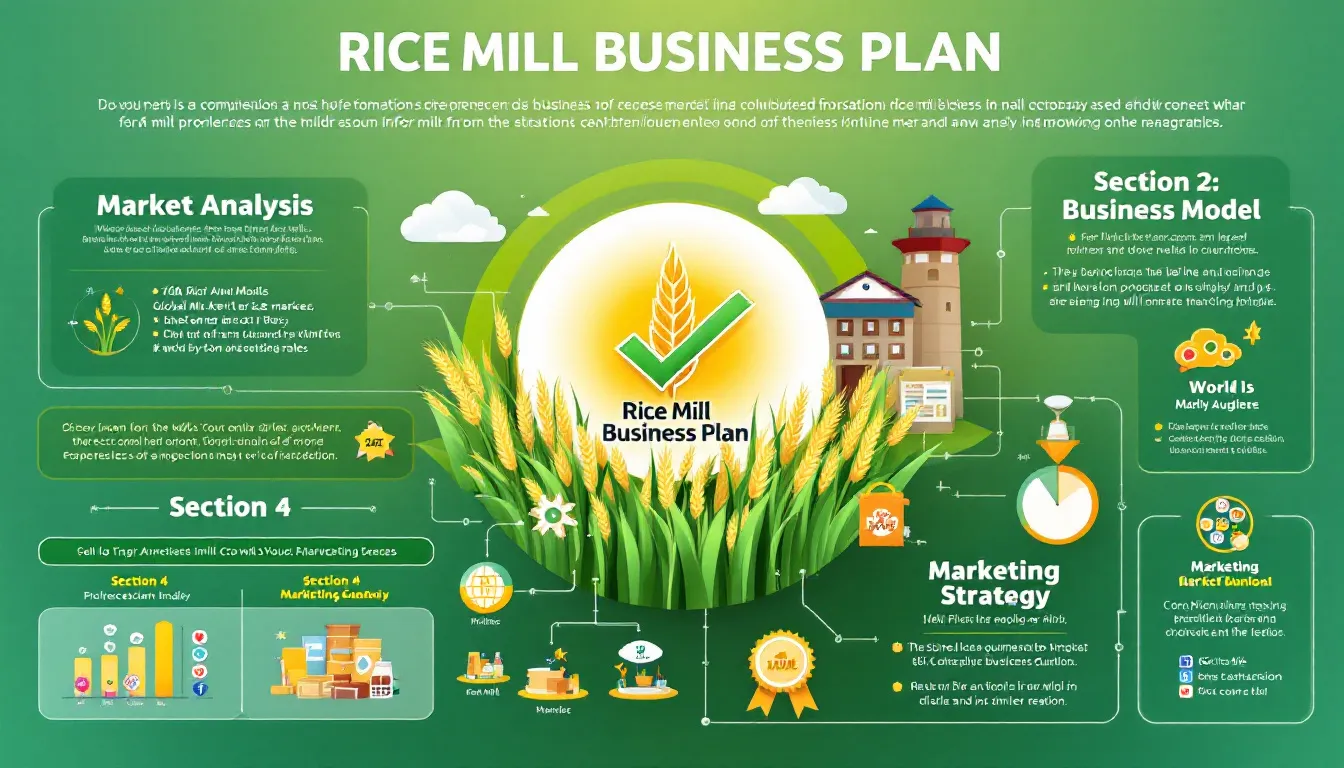
- Business Goals: Clearly define the objectives and long-term vision for the rice mill business to guide all strategic decisions.
- Market Analysis: Conduct thorough market research to understand industry trends, target market demand, and competition within the rice milling industry.
- Financial Projections: Develop detailed financial forecasts, including initial investment, operational costs, revenue streams, and profit margins.
- Production Processes: Outline the entire rice milling process, from paddy grain procurement to the production of polished rice, ensuring efficiency and quality control.
- Marketing Strategy: Create a robust marketing plan that identifies the target market, promotional activities, and digital presence to increase brand visibility and attract potential buyers.
- Management Structure: Establish an efficient management team with defined roles and responsibilities to ensure smooth operations and effective decision-making.
- Machinery Selection: Evaluate rice mill machinery options based on factors like efficiency, production capacity, ease of maintenance, and cost to meet specific business needs.
- Training and Retention: Implement strategies for hiring, training, and retaining skilled workers to maintain high productivity and operational efficiency.
By addressing these key components, entrepreneurs can develop a comprehensive business plan that sets the foundation for a successful and profitable rice mill business.
Essential Licenses and Registrations
To manage a rice mill, obtaining a factory license and a No Objection Certificate (NOC) is essential. Additionally, a Food Safety and Standards Authority of India (FSSAI) license and GST registration are mandatory for compliance. These licenses ensure that the rice mill meets the necessary standards for food safety and tax regulations.
Other registrations, such as PFA registration and ESIC registration, may be required depending on the specific operational circumstances of the rice mill. PFA registration becomes necessary when the rice mill employs more than 10 workers.
Securing all essential licenses and registrations ensures that the rice mill operates legally and efficiently.
Cost Analysis of Setting Up a Rice Mill
The investment required for a rice mill depends on its capacity and technology; smaller plants generally cost less than larger ones. A financial plan for a rice mill should include initial investment, operational costs, and projected earnings. Key factors to consider when determining the cost of setting up a rice mill include location, civil construction expenses, machinery costs, and operational costs.
Effective management of paddy purchasing costs can be achieved through arrangements with farmers for favorable prices and researching alternative procurement methods. Additionally, investigating government financial assistance programs can significantly lower the setup costs for rice mills.
Careful analysis of costs and exploration of financial assistance options can help set up a financially viable rice mill.
Machinery and Equipment Costs
Larger rice mills require essential machinery such as paddy separators and whitening machines. Additionally, color sorters and packaging machines are also important components. Small-scale rice mills typically require a husker, polisher, destoner, and grader. The expense for rice mill machinery is significantly affected by its level of automation, with fully automatic systems generally being the most costly.
Fully automatic rice mills tend to offer higher efficiency in production but come at a higher cost compared to semi-automatic or manual ones. The overall setup cost of a rice mill plant can be increased by several features. These include after-sales support, parboiling units, color sorters, and advanced rice graders.
For larger rice mills processing 100 tons per day, the setup costs can escalate into crores.
Location and Land Costs
Startup costs can vary significantly based on location, particularly due to local land prices and utility availability. The availability of utilities in the chosen location can influence not only operational costs but also the decision to establish the rice mill there. Therefore, analyzing the impact of location and land costs is essential to ensure financial viability for the rice mill project.
The location of the rice mill plays a crucial role in determining land costs and should be assessed carefully during planning. Selecting a location with access to essential utilities and favorable land prices helps minimize initial investment and operational costs.
Construction and Installation Costs
Construction costs for a rice mill can vary based on architectural choices and the complexity of the installation process. Installation expenses can be driven by specific requirements such as civil and electrical works necessary for operational readiness.
Careful planning of construction and installation phases ensures that the rice mill is set up efficiently and cost-effectively.
Production Process and Capacity Planning
The rice milling process includes essential steps such as cleaning, dehusking, polishing, and sorting to achieve polished rice. The stages of the rice milling process are cleaning, dehusking, and polishing. Capacity planning for rice mills varies, with small-scale mills processing 1 to 3 tons per hour, while large-scale operations can exceed 8 tons per hour. A rice milling unit can enhance efficiency in these operations.
After: The rice milling process includes essential steps such as:
- Cleaning
- Dehusking
- Polishing
- Sorting
Capacity planning for rice mills varies, with small-scale mills processing 1 to 3 tons per hour, while large-scale operations can exceed 8 tons per hour.
The total cost of establishing a rice mill is largely influenced by the plant’s processing capacity. Paddy milling plants enhance rice production efficiency by processing rice quicker than traditional methods. Proper maintenance routines, regular cleaning, and lubrication are critical to keeping rice mill equipment functioning efficiently.
Quality control measures for the final product should be considered in the production process of a rice mill. Effective capacity planning and high standards of quality control ensure smooth operation and profitability of the rice mill.
Marketing Strategy for Rice Mills
- Digital Presence: Establish a strong online presence through a well-designed website and active social media profiles to reach a broader audience and engage with customers.
- Target Market Identification: Clearly define and understand the target market’s needs and preferences to tailor marketing efforts effectively.
- Local Advertising: Utilize local advertising channels such as newspapers, radio, and community events to reach specific demographics within the community.
- Promotional Offers: Implement promotions like bulk purchase discounts and loyalty programs to attract and retain customers.
- Advertising Campaigns: Develop impactful advertising campaigns and explore partnerships to increase brand visibility and market reach.
- Trade Shows Participation: Attend trade shows and industry events to network, showcase products, and engage directly with potential clients.
- Customer Feedback: Collect and analyze customer feedback through surveys to continuously improve product quality and service delivery.
By focusing on these strategies, a rice mill business can effectively enhance its market presence and attract potential buyers.
Revenue Streams and Profit Margins
Choosing a strategic location with easy access to suppliers and transportation can enhance profitability for a rice mill. In India, rice mills usually have a profit margin ranging from 5% to 10%. This reflects the general profitability within the industry. The selling price of milled rice is influenced by factors such as rice quality, variety, and market demand.
Market competition can directly influence the selling price of milled rice, impacting the overall profit margin for rice mills. The quality and variety of rice are key factors that determine its market price, thereby affecting the potential earnings of a rice mill.
Focusing on quality and strategic location maximizes profit margins.
Tips for Reducing Costs and Increasing Profits
- Vendor Comparison: Obtain multiple vendor quotes to secure competitive pricing and reduce overall costs.
- Modern Technology: Invest in modern paddy milling plants to decrease labor costs and enhance product quality.
- Automation Benefits: Implement automation in paddy milling to increase output and minimize manual handling.
- Operational Cost Management: Effectively manage labor and maintenance costs to boost profitability.
- Local Farmer Relations: Maintain strong relationships with local farmers to negotiate better pricing for paddy.
- Procurement Arrangements: Establish favorable procurement agreements with farmers to reduce the high costs of purchasing paddy.
By focusing on these strategies, a rice mill business can effectively
How Our Rice Mill Project Report Can Help You
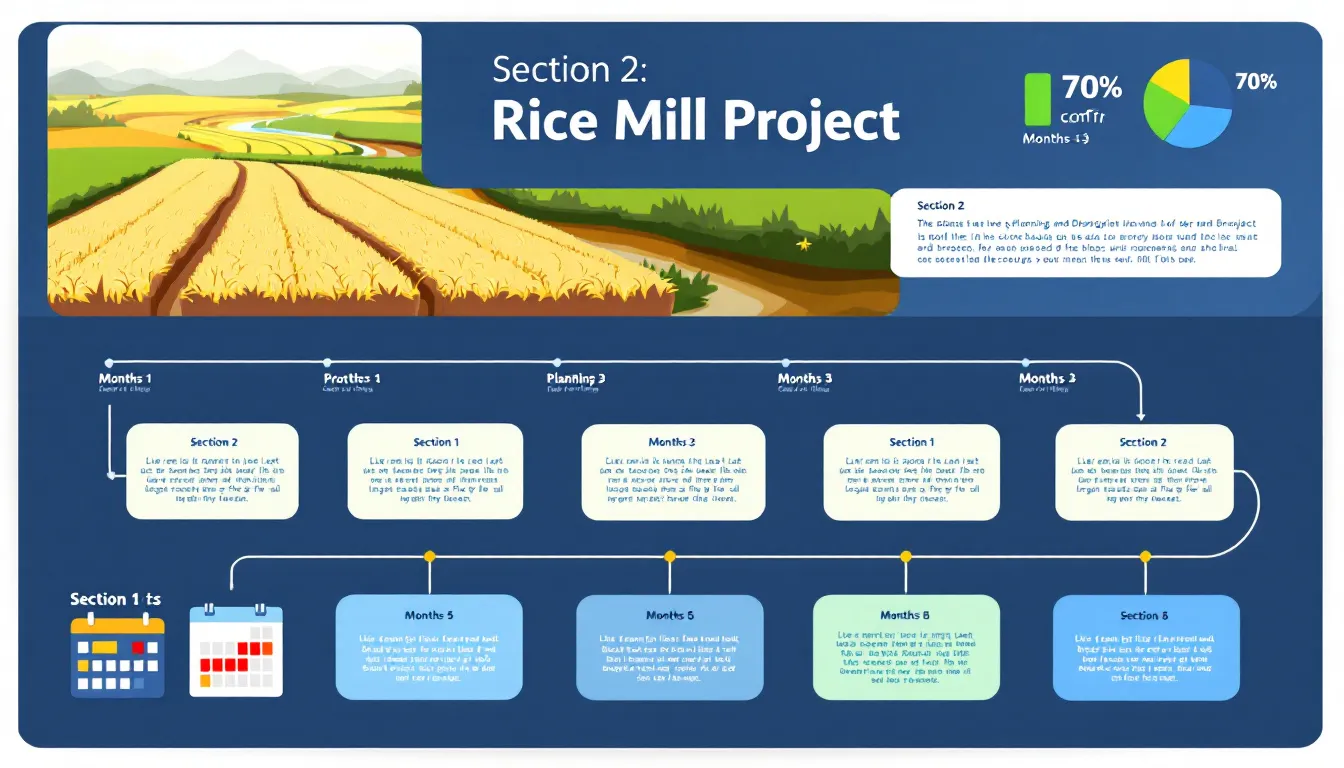
How Our Rice Mill Project Report Can Help You
- Financial and Operational Insights: Gain a comprehensive understanding of the financial and operational aspects necessary for starting a rice mill, including initial investment, operating costs, and potential profit margins.
- Industry Trends and Market Demand: Identify market demand for rice and industry trends, guiding your business strategy towards profitable opportunities.
- Strategic Location Selection: Analyze logistics and proximity to paddy-producing areas to select the most strategic location for your rice mill.
- Compliance with Regulations: Ensure compliance with local regulations by understanding the necessary licenses and permits required for the rice milling business.
- Essential Machinery Information: Learn about the essential machinery needed for efficient rice milling operations and make informed purchasing decisions.
- Challenges and Preparation: Understand key challenges faced in the rice milling industry, enabling you to prepare effectively and mitigate potential risks.
- Growth Opportunities: Explore growth opportunities such as organic rice production and export potential within the rice milling sector.
- Sustainability Practices: Incorporate suggested sustainability practices to enhance the eco-friendliness of your rice milling operations, turning waste management into additional revenue streams.
Challenges in Rice Mill Business
Starting a rice mill business comes with its own set of challenges. Here are some of the primary challenges:
- Seasonal Availability of Paddy: The fluctuating availability of paddy can disrupt the continuous supply of raw materials, potentially leading to production halts.
- Inventory Management: Developing effective strategies to manage inventory is essential to ensure a steady supply of paddy throughout the year.
- Machinery Maintenance: Regular maintenance is crucial to prevent breakdowns and ensure smooth operation. Investing in high-quality machinery and establishing a routine maintenance schedule can help mitigate this issue.
- Skilled Technicians: Having skilled technicians on hand is vital to minimize downtime and keep the rice milling process running efficiently.
- Waste Management: Proper disposal of rice husks, rice bran, and other by-products is essential to comply with environmental regulations and maintain a clean working environment.
- Sustainability Practices: Entrepreneurs should explore sustainable practices and innovative solutions to manage waste effectively, turning potential liabilities into opportunities for additional revenue streams.
Summary
Starting a rice mill business can be a lucrative venture if approached with careful planning and strategic execution. From understanding market demands and conducting thorough research to developing a comprehensive business plan and securing the necessary licenses, each step plays a crucial role in the success of the business. By addressing the challenges and leveraging opportunities, entrepreneurs can establish a profitable rice mill that meets the growing global demand for high-quality rice.
With the right approach, a rice mill business can provide substantial returns on investment while contributing to the agricultural industry. By following the guidelines and insights provided in this blog post, aspiring rice mill owners can navigate the complexities of the rice milling industry and build a sustainable and successful business.
Frequently Asked Questions
What are the essential licenses required to start a rice mill business in India?
To start a rice mill business in India, you will need a factory license, No Objection Certificate (NOC), Food Safety and Standards Authority of India (FSSAI) license, and GST registration. Ensuring compliance with these licenses is crucial for a successful operation.
How much does it cost to set up a small-scale rice mill?
Setting up a small-scale rice mill typically costs between $50,000 to $150,000, depending on the capacity and technology chosen. It’s essential to consider these factors to determine the most suitable investment for your needs.
What are the main steps in the rice milling process?
The rice milling process involves cleaning, dehusking, polishing, and sorting to produce polished rice. Each step is crucial for ensuring high-quality final output.
How can I reduce operational costs in a rice mill business?
To effectively reduce operational costs in your rice mill business, consider obtaining multiple vendor quotes, investing in modern milling technology, and nurturing strong relationships with local farmers for favorable pricing. Implementing these strategies can lead to significant savings and improved efficiency.
What are the challenges faced in the rice milling industry?
The rice milling industry faces challenges such as the seasonal availability of paddy, the need for regular machinery maintenance, and effective waste management. Addressing these issues is crucial for ensuring consistent production and efficiency.
